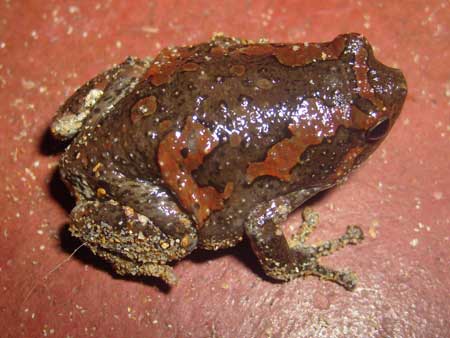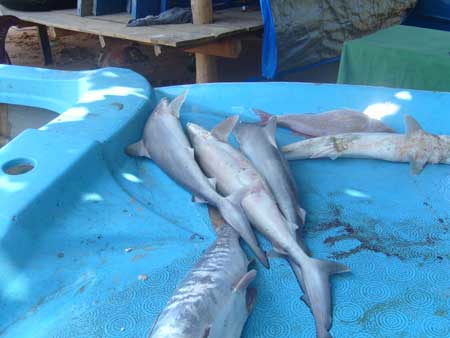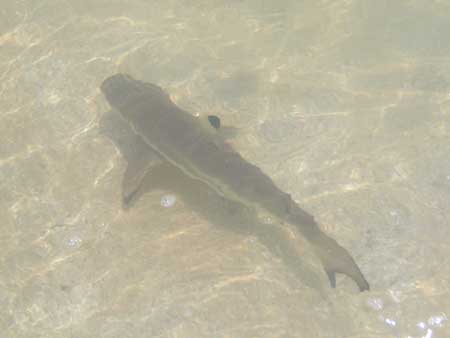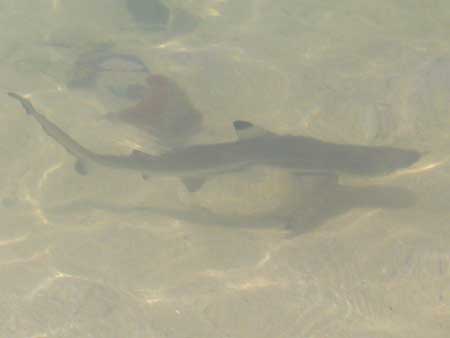Photos with this report (click to enlarge) | |||
 Toad species (2cms) |
 Shark species |
 Black-tipped Reef Shark |
|
 Black-tipped Reef Shark |
|||
Cautionary note
Most people will be aware of the civil unrest in Sri Lanka but due to the lack of reporting in the western media I doubt that the true scale of the conflict is known by many. During my time there which coincided with the end of a long standing ceasefire and the 60th anniversary of independence celebrations, there were several bus bombs which killed many innocent people and the nightly news was filled with images of government air strikes against the Tamil rebels. Sunil my guide urged me not to take any buses after I went on my own way and I was keen to heed his advice that the trains were much safer. The Tamils were seemingly unaware of this and four hours after I left Colombo’s Fort railway station heading south, a female suicide bomber killed fifteen people on the station. I can honestly say that had I known the true extent of the unrest I may not have undertaken the trip. Uda Walawe National Park was closed following an incident which saw the death of several soldiers and access to Yala National Park was greatly restricted. The absence of tourists was notable at all sites visited including the beach hot spots of Mirissa and Unawattuna.
Check the advice given on your relevant government website and make your own mind up.
Back to the birding - Sri Lanka is a little unusual in that all its endemics are gettable and had I been a more keen night birder I may have mopped up as many others do. As a backpacking birder on a longer trip to Asia my main concern was to keep costs to an absolute minimum. I managed to negotiate a package with long established tour company ‘Baurs’ which included a vehicle and driver but no specialist bird guide. This proved to be an excellent arrangement as my driver Sunil, came equipped with tapes, an intimate knowledge of all key sites including a couple of his own for tricky species, a great pair of eyes and on top of this he knew all the calls as well! I really cannot imagine how good the so called ‘bird guides’ are if Sunil is only a driver, he was quite simply fantastic and he was the sole reason that I did so well in so short a time. Sunil was always keen to please, always on time and is a very safe driver so all in all I can highly recommend him.
The agreed package was .80 cents per mile with a minimum mileage of 90 miles per day and $13 per day ‘subsistence’ for Sunil. I managed 31 of the 33 endemics in a combined total of about 4 days birding for a little over $500.
Note
I flew with Sri Lankan Airlines and it seems that they have a very bad reputation for ‘bumping’ passengers off of flights if they don’t reconfirm. Even the lonely Planet states that it’s very important to reconfirm if flying Sri Lankan. I did this easily by visiting their office in Galle.
Sites visited
I won’t give detailed site descriptions as all are well known and information is plentiful.
• Kitulgala
• Sinharaja
• Nuwara Elya for Victoria Park, Haggala Botanical Gardens and Sunil’s site for the Whistlingthrush.
Itinerary
27th Jan - Collected from my guesthouse in Negombo at 0430 by my guide Sunil De Alwis for the drive to out first destination of Kitulgala. Afternoon birding at Kitulgala and some night birding.
28th Jan - Morning birding at Kitulgala then drive to Sinharaja. Afternoon birding around ‘Blue Magpie’ gardens.
29th Jan – Morning and afternoon birding in the Park at Sinharaja.
30th Jan – Up early to go to Sunil’s own site for Sri Lanka Spurfowl then depart for the three hour drive to Uda Walawe.
31st Jan – The park at Uda Walawe was closed due to the civil war so only a small amount of birding was done here by scoping the lake from the road that runs through the middle of the park, we had to drive this road anyway on our way to Nuwara Elya.
Late afternoon visit to Sunil’s site for Sri Lanka Whistlingthrush where we also got great views of the Bush-Warbler
1st Feb - Early start in Victoria Park, afternoon at Haggala Botanical Gardens and dusk visit to Victoria Park.
Accommodation
At Kitulgala we stayed at the ‘Kitulgala resthouse’, very nice but pricey at $50 per night full board.
Sinharaja was a total rip off, the ‘Blue Magpie’ is basic to say the least and my lonely Planet had it down at 600 Rupees per night, this has risen to a ridiculous $53 full board and the food was terrible.
At Nuwara Elya I persuaded Sunil to find me somewhere a bit cheaper and I managed to get in to the ‘Green Garden’ for 1600 Rupees per night with meals extra.
* Endemics in bold
1. Spot-billed Pelican – 5 seen from the road at Uda Walawe and c20 were present on Beira Lake in Colombo
2. Indian Cormorant – A single at Kitulgala and several at Uda Walawe
3. Lesser Frigatebird – A single seen at Unawattuna.
4. Purple Heron – A single at Uda Walawe.
5. Intermediate Egret – Good numbers at Uda Walawe.
6. Great Egret - Good numbers at Uda Walawe.
7. Little Egret – Recorded at Sinharaja, Uda Walawe and Nuwara Elya.
8. Cattle Egret – Recorded daily.
9. Indian Pond Heron – Recorded daily.
10.Asian Open-billed Stork – 6 seen in trees en-route to Kitulgaa and good
numbers seen at Uda Walawe
11.Painted Stork – Several at Uda Walawe
12. Black-headed Ibis – 1 seen at Uda Walawe.
13. Crested Serpent Eagle – 1 at Sinharaja.
14. Black Eagle – 4 at Uda Walawe and 1 at Nuwara Elya.
15. Changeable Hawk Eagle – 3 at Sinharaja and 1 at Uda Walawe.
16. Sri Lanka Spurfowl – 1 male seen very well and another heard at Sunil’s site at Sinharaja. We sat quietly behind a tree and Sunil played the tape which got an instant response. We saw the male very well down to a few feet and then retreated to keep disturbance to a minimum.
17. Sri Lanka Junglefowl – 2 Females were my first at Kitulgala with several more easily seen at Sinharaja.
18. Slaty-legged Crake – A stakeout by a rubbish dump in Victoria Park has been reliable recently but it took two attempts with out first dawn effort failing. Returning at dusk provided two brief sightings but patience is needed.
19. White-breasted Waterhen – Recorded at Sinharaja and Uda Walawe.
20. Pheasant-tailed Jacana – A couple seen at Uda Walawe.
21. Avocet – Several seen at Uda Walawe.
22. Red-wattled Lapwing – A few seen at Uda Walawe
23. Black-tailed Godwit – 4 seen at Uda Walawe
24. Common Sandpiper – singles seen at Kitulgala, Victoria Park and Uda Walawe.
25. Bridled Tern – A single seemingly exhausted bird seen sat on the rocks off Unawatuna on the 12th Feb. The bird constantly flapped it’s wings and tottered from one foot to the other as it fought to keep it’s balance on the rock before it flew off behind the rocks and was not seen again.
26. Black Tern – A few at Uda Walawe and a single on rocks off Unawatuna.
27. Sri Lanka Wood-Pigeon - A total of three birds seen, two gave poor flight views at Sinharaja before I got a great, prolonged perched view of a single bird at Sunil’s Whistlingthrush site just outside Nuwara Elya.
28. Spotted Dove – Common.
29. Orange-breasted Green – Pigeon A single at Uda Walawe.
30. Ceylon Green–Pigeon – Race pompadora newly split by Rasmussen from Pompadour Pigeon and seen in good numbers at Kitulgala.
31. Green Imperial-Pigeon - Seen regularly at Kitulgala.
32. Sri Lanka Hanging-Parrot – Seen easily at Kitulgala and Sinharaja.
33. Ring-necked Parakeet – A few seen at Kitulgala and Uda Walawe.
34. Layard’s Parakeet – Heard commonly at Kitulgala but I had to wait for a decent perched view which I finally got at Sinharaja.
35. Grey-bellied Cuckoo – Sunil’s keen eyes picked this bird up as we drove along at Uda Walawe. It sat low in poolside vegetation to give excellent views without leaving the vehicle.
36. Red-faced Malkoha – One gave great views as it fed in with a mixed flock at Sinharaja.
37. Green-billed Coucal – A bird gave us the run-around at Kitulgala before we finally got very good views and then another was seen as it was mobbed by Black-naped Monarchs at Sinharaja. Very elusive.
Ceylon Bay Owl – A brief attempt for this species got no response at all to our tape at Kitulgala
Serendib Scops Owl – As above.
38. Owl sp – A very large Owl was seen briefly as it flew through the trees at Kitulgala.
39. Chestnut-backed Owlet – A species that I would probably have missed were it not for Sunil knowing a nest site at Kitulgala. The species was not heard at all during my trip but great views were had of a bird sat outside it’s nest hole in someone’s garden during the day. A small payment whilst not asked for (though possibly expected), was made to the home owner for allowing access.
40. Crested Tree-Swift – A few seen at Sinharaja.
41. Malabar Trogon – Singles seen at Kitulgala and Sinharaja.
42. Stork-billed Kingfisher – One at Kitulgala.
43. White-throated Kingfisher – Common.
44. Common Kingfisher – Singles at Kitulgala and Uda Walawe.
45. Little Green Bee-eater – A few seen at Uda Walawe.
46. Chestnut-headed Bee-eater – Three seen at Kitulgala and one seen at Sinharaja.
47. Indian Roller – A few seen at Uda Walawe.
48. Sri Lanka Grey Hornbill – Six birds seen en-route to Kitulgala were my first endemics of the trip. Seen subsequently at Kitulgala and Sinharaja.
49. Malabar Pied Hornbill – Two seen at Uda Walawe.
50. Brown-headed Barbet – Heard or seen daily.
51. Ceylon Small Barbet – Race rubricapilla split by Rasmussen from Crimson-Fronted Barbet. I nearly messed up with this one by assuming I’d eventually bump in to one as they had been heard everywhere. I left Sunil having still not seen one but fortunately they are very common and a fruiting fig tree in the coastal resort village of Unawatuna saved my blushes with c6 present every time I passed the tree.
52. Yellow-fronted Barbet – Easily seen at Kitulgala and Sinharaja.
53. Brown-capped Pygmy Woodpecker – A couple seen at Nuwara Elya.
54. Lesser yellownape – A couple seen at Sinharaja.
55. Black-rumped Flameback – One at Sinharaja.
56. Crimson-backed Flameback – Race stricklandi split by Rasmussen from Greater Flameback and only one seen at Kitulgala.
57. Oriental Skylark – One at Uda Walawe.
58. Bengal / Jerdon’s Bushlark – A few at Uda Walawe.
59. Ashy-crowned Sparrow-Lark- A few at Uda Walawe.
60. Barn Swallow – A few seen at Uda Walawe.
61. Ceylon Swallow – Race hyperythra formerly included with Red-rumped Swallow. Several seen en-route to and at Kitulgala, then again at Uda Walawe.
62. Grey Wagtail – One at Victoria Park.
63. Forest Wagtail – One at Victoria Park.
64. Paddyfield Pipit - A few seen at Uda Walawe.
65.Black-capped Bulbul – Race melanicterus split by Rasmussen from Black-crested Bulbul, 4 seen at Kitulgala.
66. Red-vented Bulbul – Common.
67. Yellow-eared Bulbul – Three seen in Victoria Park.
68. Black Bulbul – Fairly common.
69. Yellow-browed Bulbul – Seen at Kitulgala and Sinharaja.
70. Scarlet Minivet – Fairly common.
71. Golden-fronted Leafbird – One seen at Kitulgala.
72. Common Iora. Common.
73. Indian Blue Robin – One in Victoria Park.
74. Indian Robin – A couple at Uda Walawe.
75. Oriental Magpie Robin – Common.
76. Pied Buschat – A couple at Uda Walawe.
77. Sri Lanka Whistling-Thrush – This can be a tricky one to see but Sunil has a fairly reliable site near Nuwara Elya. We stood above a stream for about an hour before I saw a bird fly up stream in to an area completely covered over by bushes. Fortunately access was easy by simply walking up the tunnel created by the bushes and as I peered around a bend in the stream the female bird could be seen feeding at the stream side.
78. Pied Thrush – Three birds seen easily in Victoria Park, the key seems to be paying 100 Rupees to the gatekeeper to let you in early before the gates are officially open. Two males and a female were seen feeding on the grass but within half an hour they had moved up in to the trees and out of sight for the rest of the day.
79. Spot-winged Thrush - Two birds seen at Sinharaja, the first was tricky to see but the second gave prolonged perched views near it’s nest.
80. Ceylon Scaly Thrush – One only in Victoria Park.
81. Sri Lanka Bush-Warbler – Excellent views of a bird feeding on a small refuse dump behing the fruit stall at the Whistling-Thrush site.
82. Clamorous Reed Warbler – A couple in Victoria Park.
83. Jungle Prinia – A few at Uda Walawe.
84. Common Tailorbird – A few at Kitulgala and Sinharaja.
85. Green Warbler – One only at Kitulgala.
86. Grey-headed (Canary) Flycatcher – One only at the Whistling-Thrush site.
87. Tickell’s Blue Flycatcher – Three seen at Victoria Park.
88. Dull Blue Flycatcher – Struggled to get good views of this bird as it stayed quite high in the trees most of the time but eventually two were seen well at Haggala Botanical Gardens.
89. Kashmir Flycatcher – A super male was watched sallying from a small tree in Haggala Botanical Gardens and was the only one of the trip.
90. Black-naped Monarch – Noted at Sinharaja only.
91. Asian Brown Flycatcher – Singles seen at Kitulgala and Sinharaja.
92. Oriental White-eye – A few seen at the Whistling-Thrush site.
93. Sri Lanka White-eye – A small party seen in Victoria Park.
94. Great Tit – A few seen in Victoria Park.
95. Brown Shrike – Singles noted at Kitulgala and Uda Walawe.
96. Ceylon Woodshrike – Race affinis split from Common Woodshrike by Rasmussen. One only seen perched treetop at Kitulgala.
97. Ceylon Crested Drongo - Race lophorhinus split from Crested Drong by Rasmussen. Two seen at Kitulgala.
98. White-bellied Drongo – Singles seen at Kitulgala and Sinharaja.
99. Tawny-bellied Babbler – A small party moving through a tea plantation as we walked to the Spurfowl site at Sinharaja.
100. Orange-billed Babbler – Seen daily at Kitulgala and Sinharaja.
101. Yellow-billed Babbler – Common.
102. Dark-fronted Babbler – Noted at Kitulgala and Sinharaja.
103. Brown-capped Babbler – Sunil heard one singing as we rested at our lodge at Sinharaja and we tracked down what was to be the only one of the trip.
104. Ceylon Scimitar-Babbler – Only seen at Sinharaja where three.
105. Ashy-headed Laughinghthrush - Only seen at Sinharaja where a party of c6 was seen.
106. Sri Lanka Magpie – Three seen at Sinharaja.
107. House Crow – Common.
108. Large-billed Crow - noted at Sinharaja and Uda Walawe.
109. Hill Mynah – Two seen at Kitulgala.
110. Sri Lanka Mynah – The only one seen was perched in a tree, singing outside my room at the ‘Blue Magpie’ at Sinharaja.
111. Common Mynah – Common.
112. White-faced Starling (endemic) – Three seen at Sinharaja including very good scope views.
113. White-throated Flowerpecker – Singles noted daily at both Kitulgala and Sinharaja.
114. Pale-billedFlowerpecker – Noted at Kitulgala and Sinharaja.
115. Purple-rumped Sunbird - Noted at Kitulgala and Sinharaja .
116. Purple Sunbird – Two seen at Uda Walawe.
117. Black-hooded Oriole - Noted at Kitulgala and Sinharaja .
118. Black-headed Cuckooshrike – One seen at Sinharaja.
119. White-rumped Munia – Common.
120. Hill Munia – Two seen at Kitulgala.
121. Black-headed Munia – A couple seen at Kitulgala.
122. House Sparrow - Noted at Sinharaja and Uda Walawe.
Mammals seen.
Asian Elephant – Good numbers seen at Uda Walawe where they come up to the electrified boundary fence to be fed!
Sri Lankan Giant Squirrel – A couple seen at Sinharaja were of the Black form.
Purple-faced Leaf Monkey – Seen at Sinharaja and Unawatuna.
Toque Macaque – A couple at Sinharaja.
Layard’s Striped Squirrel – Common.
Common Palm Squirrel – Common.
Reptiles
Monitor sp – One at Sinharaja.
Hawksbill Turtle – Commonly seen at Unawatuna and Mirissa beach where nests were found by following the obvious trails left on the beach by the Turtles. This unfortunately also meant that the locals could easily find them and all the nests I found had been dug up and the eggs taken. There is though the hope that the eggs were sold to the local Turtle sanctuary who pay more than the going rate for them in the hope that they won’t get eaten by the locals.
Toad sp – A tiny (c2cm) poisonous looking toad found in a beachfront bar at Mirissa, see photo above. Any ID help appreciated (Thanks to surfbirders who have subsequently confirmed that it is an Indian Painted Frog / Sri Lanka Bullfrog Kaloula taprobanica).
Fish
Black-tipped Reef Shark – A small one swimming on the tideline at Unawattuna was unexpected, see photo above.
Finally a thank you to my guide Sunil De Alwis of ‘Baurs’ without whom I’d have seen very little. I cannot recommend him highly enough, he really knows all the sites (plus a few of his own) and the birds inside out.
www.travel.baurs.com/images/birds_r14_c5.jpg
www.travel.baurs.com/images/guide_team.jpg